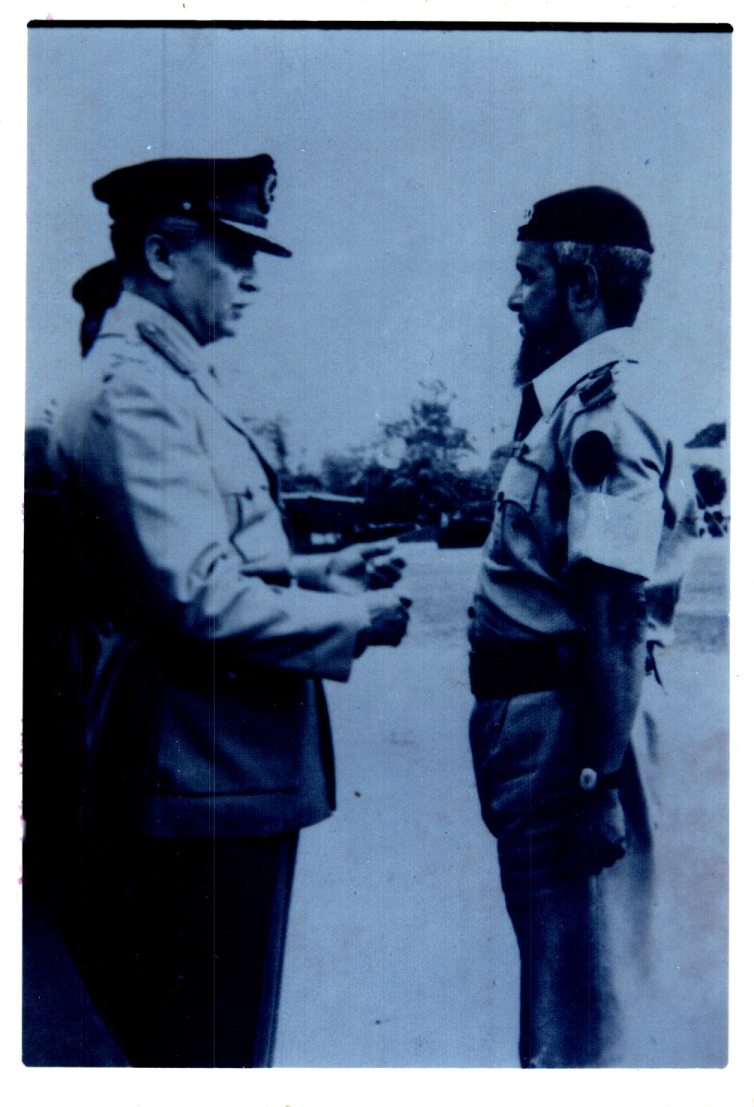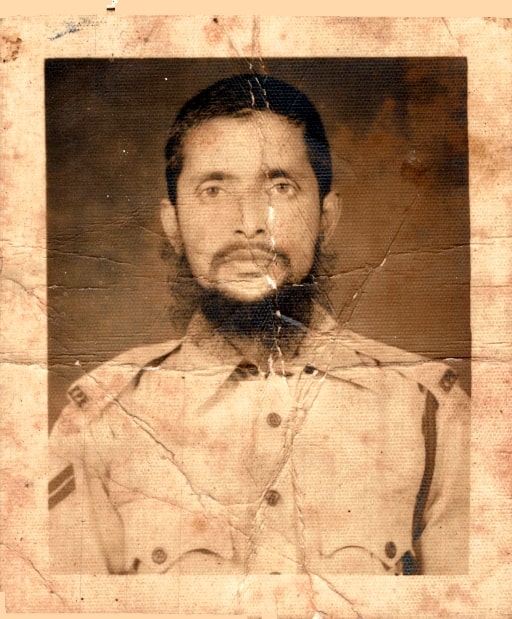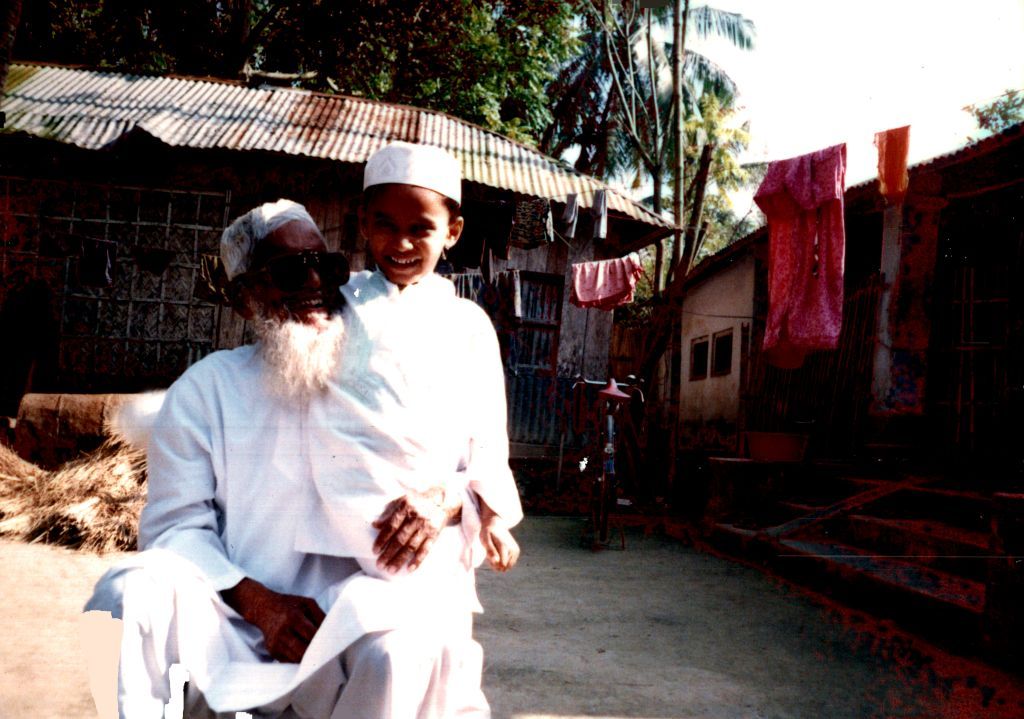Zahid Rahman
During Bangladesh’s liberation struggle, out of all the fearless and patriotic people who have fought in the battlefields 676 freedom fighters were awarded various titles of heroism for their great valour and bravery; among which, the BirBikrom title was awarded to only 175 of the freedom fighters and Bir Bikrom Syed Amiruzzaman had been one such recipient.
In 1971, Amiruzzman was posted as a Havildar of the EPR force and served as the “main signal mechanic” for the Rajshahi sector headquarter. During the great war of ’71, he was a platoon commander of sector number seven’s fourth Lalgola sub sector’s liberation war group. This sector essentially consisted of the huge number of EPR members located in northern Rajshahi and Dinajpur.

Liberation war and all his different life-stories are compiled in Syed Amiruzzman’s book Bangladesher Muktijuddho: Ekjon Sainiker Sritikotha [The Liberation war of Bangladesh: A soldier’s memoir”. The book was published in 2008 during the Ekushey Book Fair. His birth and various life struggles including narration of various war incidents during his time serving for Sector 7 is beautifully illustrated in his book. At the same time, he has also described his own opinions and views.
Summary of Syed Amiruzzman’s duties during the war of liberation:
1) On the night of 25th March, when the Pakistani invading forces started indiscriminate killings of the innocent Bengalis in different parts of the country, freedom fighter Amiruzzaman waited for no one’s orders and in his own accord, via the wireless signal, spread messages of patriotism and bravery among his co-workers. He invited everyone to join the war. Via the signal office’s radio, he further alerted the Bangladesh police and the other freedom fighters of the whereabouts of the invading forces as well as other details of war.
2) Under the leadership of Bir Bikrom Syed Amiruzzman, on 27th March, the Bengali soldiers broke the arsenal of the then EPR headquarters of Rajshahi and seized arms and ammunition.
3) On the 27th, along with the freedom fighters progressing from Naogaon, he met with Subedar Monowar at Nowhata.
4) On the night of the 30th, along with his friend Aminullah and signal operator Moizuddin, he carried all the radio equipment of the sector and took shelter at the house of Major Mohammad Shawkat. He then began all necessary signal arrangement.

5) On the 31st, he walked on foot from Rajshahi to the Shordoho Police Education Centre to meet with Captain Rasheed. On his way home, he met with the troops coming from Naogaon at Baneswar. They let their need of radio equipment known to Amiruzzaman. After that, Amiruzzaman returned to Kazihata, Rajshahi, to the house of Subedar Major Mohammad Shawkat.
6) On 1st April, he carried the signal equipment to Baneswar and returned to Rajshahi city on 2nd April.
7) On 4th April, with all the radio equipment from the EPR sector’s signal branch, he joined with Major Gias taking with him his co-worker and friend Aminullah.
8) On 13th April, Rajshahi city was captured by the Pakistani invading forces. Captain Gias’s force had left their weapons and ammunition at the Muraripur headquarters and formed a base at Abhaya. On 15th April, Amiruzzaman, on his own initiative, took along with him the Bihari driver Fateh Mohammad, Sajemul Haque, and Kala Miah and retrieved the freedom fighters’ weapons and ammunition from Muraripur and brought them to the base at Abhaya.
9) In the month of May, he led Bir Protik Bodiuzzaman Tunu, Muhammad Saidur Rahman, Mahabub Ul Gani Bablu, Mir Mohammad Morshed Ali Bokul, and Nasirul Huda Bachu; and cut off the electricity supply of Rajshahi city by destroying the 33,000 V power line. (This was aired on Swadhin Bangla Betar)
10) In the month of June, he led Muhammad SaidurvRahman, MahabubvUl GaniBablu, Mir Mohammad Morshed Ali Bokul, and Nasirul Huda Bachu cut off the rail connections with Rajshahi by destroying the Kapasia rail line. (This was aired on Swadhin Bangla Betar)
11) In the month of June, when an international team of observers visited Rajshahi city for inspection, to alert the active presence of the freedom fighters, he conducted several grenade attacks.(This was aired on Swadhin Bangla Betar)
12) Under his leadership a group of freedom fighters killed infamous Rajakar Bahar Khan at Charghat. ( The news was aired on Swadhin Bangla Betar)
13) He set up a liberation war camp at Chilmari village at Daulatpur, Kushtia.
14) He actively participated in the demolition of Haripur Bridge on the Rajshahi-Chapainawabganj road on 15th August. (This was aired onSwadhin Bangla Betar)
15) He took active part in the Abhaya Bridge operation on the Rajshahi-Chapanbabganj road.
16) On September, at Narendrapur of the Chapainawabganj Upazila headquarters, he set up a base for the advancing freedom fighters. He served there until November 12 and took part in various skirmishes.
17) In the then Chapainawabganj subdivision at Islampur, during the terrible battle on the night of 11th November, he provided 3-inch-mortar support for the advancing freedom fighters. In this battle, the freedom fighters were trapped in the River Padma. On November 12, at 10 a.m. he led the expedition for the rescue of the trapped freedom fighters and got wounded in the battlefield. He took treatment in the Berhampore hospital in India. On 20th February, 1972, he returned home.
Bir Bikrom SyedAmiruzzman was born in January 1927 in Harindi village under Sreepur Upazila of Magura District. His parents were Syed Abdul Wahed and Mosammat Altafunnesa. Five brothers – Syed Bodiuzzaman, Syed Imam Jafor Sadiq, Syed Imam Saiful Islam, and Syed Mohammad Halimuzzaman; and two sisters, Sayeda Anowara Begum and Sayeda Moriom Khatun – among them, he is the third. One thing is mentionable, his younger sister, Sayeda Moriom Khatun’s husband, Munshi Mujibur Rahman, was murdered during the liberation war by Magura’s notorious Razakar Riju and Kabir.
Amiruzzaman received his education at Maktab at the adjoining Madanpur village of Jessore District board. At Maktab, as his primary teacher, he received the renowned Moulvi Abdur Razzak of Tunipara village. After studying at Maktab for three years, he went to live with his married older brother, Syed Bodiuzzaman, at his house in Kolkata. Syed Bodiuzzaman passed his B.A. degree from Kolkata University in the year 1915. He was the officer-in-Charge of Khidirpur police station as an inspector of the Kolkata police. Amiruzzaman was admitted to third grade in 1935 at Khidirpur Academy School in Calcutta. He studied in this school till sixth grade.
In 1939, due to the death of his father and his older brother’s illness, he had to return from Kolkata to Magura. Accomodation at Magura was arranged at Syed Bodiuzzaman’s “Mirmanzil” house at College Road of the present town. He got admitted to the Magura high school. At that time, Magura high school’s head teacher was Babu Prafulla Kumar Ghosh. Amiruzzaman was not only a player of the school football team but also the school team’s captain. He matriculated from Magura High School in 1946.

For various family reasons, without pursuing higher education, after matriculation he gets admitted to G.T. training school for receiving “Guru training” in order to earn a living. But, realizing that the teaching profession will not be of much help, he started studying homeopathy under the then famous homeopathic doctor of Magura, Azizur Rahman Khan, M.H, M.S. Being a young man of bohemian nature, Amiruzzaman could not study homeopathy for a long time. So, he resigned the study of homeopathy and returned to his village. After returning home, he expressed his desire to learn Islam in an institutionalized way under his Pir Qibla Alhaj Maulana Shah Sufi Touazuddin Ahmed. On the advice of Huzur Qibla, he got admitted to the Dobra madrasa established by Alhaj Maulana Abdul Gofur in Boalmari Upazila of Faridpur District. While receiving education at the madrasa, he had to return home due to his mother’s illness. In the meantime, he got married with Rizia Khatun, elder daughter of Khondokar Ishaq. Rizia Khatun’s two uncles, Khondokar Nazat Ali and Khondokar Sujayet Ali become the key organizer of Akbar Bahini of Sreepur during the Liberation War. After marriage Amiruzzaman started teaching at the private primary school at Sreepur. At that time, the head teacher of the school was the renowned teacher, Abdur Rahman, from the Baroipara village.
In the year 1952, after the end of the language movement, he left the teaching profession and went to Dhaka in the hope of a better job. At Dhaka, he started his career with type writing education and acted as a manager at the same type writing school.
On 15th April, 1953, he joined the then East Pakistan Rifles force’s Signal branch as a soldier. At the end of the radio and soldier training, he was posted as a “Signal Mechanic” at the EPR force’s Signal Wing and Central Workshop. There, he worked under Subedar Major Mohammad Shawkat Ali (Shaheed).
In June, 1962, he went to Chittagong Hill Tracts to install signal system at the Chittagong Hill Tract outposts. From June till August, for three months, he resided in the Chittagong Hill Tracts and kept a diary of his mountain life. The diary of his hill life was published posthumously on February 2011 under the name Ramgarer Diary (Ramgar’s Diary).
In the year 1963, he was transferred to the post of Signal Mechanic in the Signal branch of the Rajshahi sector headquarters of the EPR force. In 1965, he played an important role in the Indo-Pak war and received state awards. In 1968, he received a promotion and became a Havildar.
As a result of independence, East Pakistan Rifles was named “Bangladesh Rifles”. After Amiruzzaman was promoted to Naib Subedar, the Rifles force’s headquarters were transferred to Dhaka and there he performed his duties in the Signal branch’s “Central Signal Workshop” as an Officer-in-Charge. In the year 1976, for higher training on wireless technology, Bangladesh government sent him abroad. After finishing his training, he returned to his country and got promoted to Signal Subedar and performed duties at the “Central Signal Workshop”. The then Rifles force played an important role in the development of the signal system throughout the whole country.

In the BDR forces, the senior “Wireless Mechanic” position was not present in any sector other than the Dhaka headquarters. Amiruzzaman was the only senior JCO- wireless mechanic. However, in an irrational and out of order way, just a year and a half before retirement, the then Rifles force’s Director General, Major General Golam Moktadir, sent an order of transfer to Chittagong for the freedom fighter Bir Bikrom Amiruzzaman. He legally informed the Director General and appealed for transfer in the Jessore sector if required. All the attempts and recommendations for transfer to Jessore sector by the Deputy Director of the force, the valiant freedom fighter, Major General Ain Uddin, were ignored and Amiruzzaman was transferred to Chittagong. 15 days after the incident he voluntarily retired on 14 August, 1985. Till the day he died, Amiruzzaman believed, “I was a victim of this irregularity because I fought in the liberation war”.
In his personal life, Bir Bikrom Amiruzzaman was a honest, humble, wise and enlightened person. His commentary on society, religion, and liberation war has always garnered the praise of everyone. Wherever he would go, he would advise people to stay true and good. He believed, only honesty keeps people alive for a lifetime and this is one of the philosophies of the liberation war. He has lived by this philosophy throughout his life and has advised others to follow as well.
On 18th January, 2010, this brave warrior of the liberation war left us silently. This is life’s ultimate destiny. On 19th January, he was buried in state honours beside his mother in the family cemetery, at his hometown in Sreepur’s Harindi village of the Magura District.
Zahid Rahman is a Writer and Liberation War Researcher. He is the Chief Coordinator of Muktijuddhe Magura Gobeshona Kendro.
The article was published in a booklet titled Bir Bikram Syed Amiruzzaman.
The article is translated by Tasnim Kabir Odrika.
